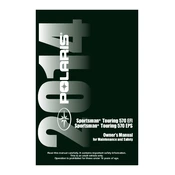Polaris Sportsman Touring 570 EFI Owner's Manual


To perform a basic oil change, first warm up the engine. Then, place an oil pan beneath the drain plug, remove the plug, and let the oil drain completely. Replace the oil filter, reinstall the drain plug, and refill with the recommended oil type and capacity.
If the ATV won't start, check the battery connections and ensure they are tight and clean. Verify that the fuel is fresh and the fuel valve is on. Inspect the spark plug for wear or damage and replace if necessary.
It's recommended to check the tire pressure before each ride. Use a tire gauge to ensure the pressure is at the manufacturer's recommended levels to prevent uneven wear and ensure optimal performance.
Use a high-quality, ethylene glycol-based antifreeze with corrosion inhibitors specifically formulated for aluminum engines, mixed with distilled water at a 50/50 ratio.
Remove the air filter cover and take out the air filter. Clean it with a mild detergent and water, rinse thoroughly, and let it dry completely before reinstalling. Replace the filter if it is damaged or excessively dirty.
Regularly inspect the brakes, fluid levels, tire conditions, and drive chain or belt. Also, check the throttle and brake controls for proper operation and ensure all fasteners are tight.
Check the coolant level and ensure there are no leaks. Verify that the radiator is clean and free from obstructions. Inspect the fan operation and thermostat, and replace them if necessary.
To store for the winter, clean the ATV thoroughly, change the oil, and fill the fuel tank with fresh gas and stabilizer. Disconnect the battery and store it in a cool, dry place. Cover the ATV to protect it from dust and moisture.
Maintain the engine with regular services, ensure the tires are properly inflated, avoid excessive idling, and use the recommended fuel grade. Reducing extra weight and riding at moderate speeds can also enhance fuel efficiency.
If the brakes feel spongy, check the brake fluid level and top it off if necessary. Inspect brake lines for leaks or air bubbles, and bleed the brakes to remove any trapped air. Replace worn brake pads as needed.